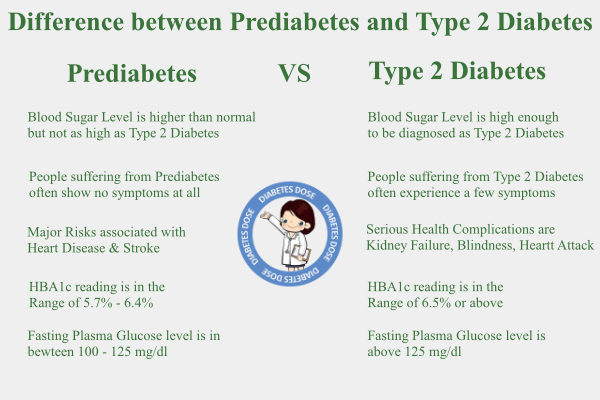What is the Difference between Prediabetes and Type 2 Diabetes
A lot of people seem to have many preconceived notions about Prediabetes. Although it is just an onset of Type 2 Diabetes, some people believe that it is a type of Diabetes in itself. There is a lot of difference between Prediabetes and Type 2 diabetes but there are similarities in them too. Once you know the actual differences between them, you will have a better understanding of both the conditions.
Prediabetes vs Type 2 Diabetes: Distinguishing Factors
There are a number of factors on which we can distinguish Prediabetes and Type 2 Diabetes. These factors help to diagnose both the conditions clearly so that it becomes easier to control them. Let’s see some of the major differentiating factors between Prediabetes and Type 2 Diabetes.
Blood Sugar Levels
This is the prime differentiating factor through which we can label a person’s condition as normal or Prediabetes or Type 2 Diabetes.
- Prediabetes: In this condition, the blood sugar level is higher than normal but not as high as to be termed as Type 2 Diabetes.
- Type 2 Diabetes: When a person’s blood sugar level is high enough to be diagnosed as Diabetes.
Symptoms
The mild symptoms of Type 2 diabetes can be seen in Prediabetes but most of the times there are no symptoms. This is how one can differentiate Prediabetes from Type 2 Diabetes based on the symptoms they show. Thus, it is recommended to go through regular diabetes check-up for screening your blood sugar levels.
- Prediabetes: People suffering from Prediabetes often show no symptoms at all and it can only be diagnosed through a blood test for measuring blood sugar levels.
- Type 2 Diabetes: Usually, a “Sugar Disease” like Diabetes doesn’t depict any kind of symptoms but people suffering from Type 2 Diabetes often experience increased thirst, frequent urination, blurred vision, tiredness and fatigue along with a few other symptoms.
Risk of Progression
The main distinguish factor between Prediabetes and Type 2 Diabetes is risk of progression.
- Prediabetes: In case, it is not treated well or no medication is taken to control it, then the risk of developing Type 2 Diabetes increases. The other major risks associated with Prediabetes are heart disease and stroke.
- Type 2 Diabetes: It is quite more dangerous than Prediabetes in terms of risk factors and long term complications associated with it. If it is poorly managed or not controlled within time then it can lead to serious health complications such as kidney failure, nerve damage, heart attack, blindness, stroke, dementia and several other infections.
Haemoglobin A1C (HbA1c) Test
It is a common blood test to estimate the average blood sugar levels in the body (past 2 to 3 months) to diagnose both Prediabetes and Type 2 Diabetes.
- Normal: Below 5.7%
- Prediabetes:5.7% to 6.4%
- Type 2 Diabetes:6.5% or Higher
The percentage shows the amount of glucose (sugar levels) glycated (bound) to haemoglobin in the red blood cells.
Fasting Plasma Glucose (FPG Test)
This is the major differentiator through which we can classify both the conditions. Usually, the fasting plasma glucose level should be less than 100 mg/dl for a normal well-being when tested through a Fasting Plasma Glucose test.
- Prediabetes: If the fasting plasma glucose level is lower than 126 mg/dl but more than 100 mg/dl then a person is said to be diagnosed with Prediabetes. Basically, it is in between 100 to 125 mg/dl in this condition.
- Type 2 Diabetes: If the fasting plasma glucose level is 126 mg/dl or higher, a person is said to have Type 2 Diabetes and necessary measures must have taken to control it.
Treatment
Treatment for both the conditions differs to a certain extent. Although some treatment methods such as a change in lifestyle, regular exercise as well as diet plan are necessary for both, but medication can differ.
- Insulin injections can be prescribed for Type 2 Diabetes but it is not needed for people with Prediabetes.
- Since the blood sugar level is lower in Prediabetes than in Type 2 Diabetes, the treatment mode and techniques relatively differ for both of them.
But as the nature of diagnosis is similar in both, some of the treatment prescribed by the doctor can be similar in some cases.

